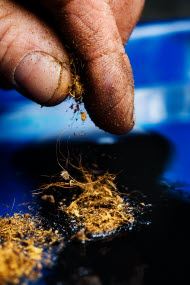
|
|
The peat moss is a remarkably good absorbent. Photo: Sverre C. Jarild. |
SINTEF “Expertise broker” Leif Estensen connects researchers with companies that lack research and development experience. Three years ago, he brought Kallak and SINTEF together.
An expertise broking project was set up with scientists from SINTEF's Marine Environmental Technology department, with the aim of testing different types of peat moss and documenting their properties.
The conclusions drawn from the testing programme were quite clear: the peat moss had excellent potential, as since its ability to take up oil was as good as, or in some cases even considerably better than, other products already available on the market.
Used in the “Full City” incident
In the summer of 2009, the Panama-registered “Full City” ran aground off Langesund on the south-east coast of Norway, causing severe oil contamination along much of the coast. This incident gave Kallak Torvstrøfabrikk the chance to demonstrate the efficacy of its new product on land.
Svein Ramstad of SINTEF's Marine Environment department says that the peat moss was deployed on a geological conservation area near Langesund and at Stavern. The area was heavily contaminated, and particular care needed to be taken. Gravel and stones were mixed with the peat moss and were laid back in their original position, to good effect.
Further activities
Kallak Torvstrøfabrikk has recently developed a series of other products based on its peat-moss absorbent material, such as three metre-long “sausages” and buckets of peat moss, which the fire brigade and operators of heavy machinery can use in the event of spills of oil, diesel fuel or other environmentally hazardous liquids.
The peat moss mixtures have been laboratory tested on various types of crude oil and bunkers oil. In 2008, the little company won an industrial research and development contract with Veolia Miljø for product development and commercialisation, and it is now looking at potential sales elsewhere in Europe.
